(完整版)有源降噪研究毕业设计
南京大学的有源噪声控制研究——纪念沙家正先生

南京大学的有源噪声控制研究——纪念沙家正先生邱小军【摘要】沙家正先生是中国有源噪声控制研究的开创者,著名声学家、南京大学教授.详细讲述了南京大学有源噪声控制的研究过程以及沙正明、沙家正、田静、邱小军、杨军、邵军等人所做的研究工作,尤其是沙老师对中国有源噪声控制所做的贡献.【期刊名称】《电声技术》【年(卷),期】2014(038)009【总页数】4页(P36-39)【关键词】有源噪声控制;管道有源消声器;有源抗噪声送话器【作者】邱小军【作者单位】南京大学声学研究所,江苏南京210093【正文语种】中文【中图分类】TN9721 引言中国有源噪声控制研究的开创者、著名声学家、南京大学教授、沙家正先生2014年5月14日在南京病逝,是中国声学界的重大损失。
作为先生的第一位博士研究生,我感到分外悲痛。
1992年,因为久慕先生的学术成就,我从北京大学转到南京大学声学研究所攻读博士学位,有幸在先生引导下,进入有源噪声控制研究领域。
毕业后留校,进入先生的课题组工作。
2001年,先生退休,我接下先生的衣钵。
从入门到现在,一晃20多年过去了,先生早年播种的有源控制研究的种子已从嫩芽经过茁壮成长进入开花结果阶段,正在拓展更广泛的应用领域。
目前,南京大学的有源控制研究水平在世界领先:课题组的研究人员应邀在世界级噪声大会做大会报告,并在南京大学和世界各地组织有源控制研讨会;课题组开发了迄今世界上最先进的多通道自适应有源控制器,已在全世界展开销售;课题组和世界各地的相关科研单位和相关企业建立了紧密的合作关系。
这一切都起源于先生在20世纪80年初的远见卓识。
本文梳理南京大学的有源控制研究,时间跨度从南京大学有源控制相关第一篇论文发表到2001年沙先生在南京大学退休,以此纪念沙先生,并探求本研究方向发展的规律。
2 有源噪声控制研究过程虽然有源噪声控制的思想早在1936就已被Lueg提出[1],且20世纪50年代在电子吸声器和变压器噪声控制方面有初步的尝试[2-3],但由于当时电子技术的水平和系统理论分析的缺乏,一直没有得到有效发展。
【完整版毕业论文】巴特沃斯有源低通滤波器的设计
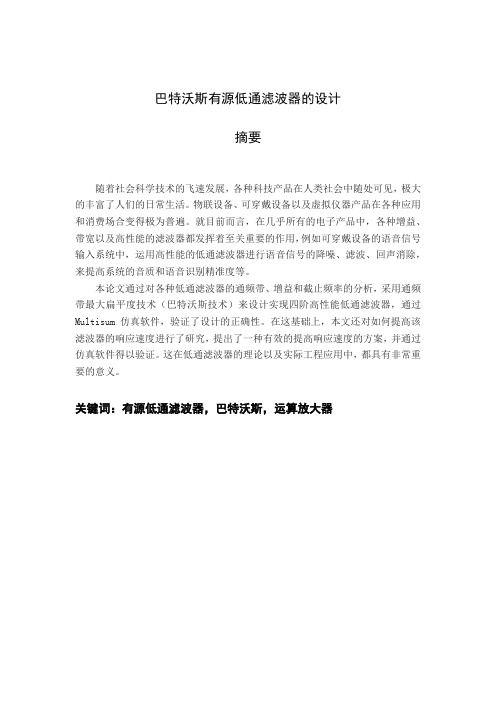
巴特沃斯有源低通滤波器的设计摘要随着社会科学技术的飞速发展,各种科技产品在人类社会中随处可见,极大的丰富了人们的日常生活。
物联设备、可穿戴设备以及虚拟仪器产品在各种应用和消费场合变得极为普遍。
就目前而言,在几乎所有的电子产品中,各种增益、带宽以及高性能的滤波器都发挥着至关重要的作用,例如可穿戴设备的语音信号输入系统中,运用高性能的低通滤波器进行语音信号的降噪、滤波、回声消除,来提高系统的音质和语音识别精准度等。
本论文通过对各种低通滤波器的通频带、增益和截止频率的分析,采用通频带最大扁平度技术(巴特沃斯技术)来设计实现四阶高性能低通滤波器,通过Multisum仿真软件,验证了设计的正确性。
在这基础上,本文还对如何提高该滤波器的响应速度进行了研究,提出了一种有效的提高响应速度的方案,并通过仿真软件得以验证。
这在低通滤波器的理论以及实际工程应用中,都具有非常重要的意义。
关键词:有源低通滤波器,巴特沃斯,运算放大器Design of Butterworth Active Low Pass FilterABSTRACTWith the rapid development of social science and technology, various technological products can be seen everywhere in human society, which greatly enriches people's daily lives. IoT devices, wearable devices, and virtual instrument products have become extremely common in various applications and consumer occasions. For now, in almost all electronic products, various gains, bandwidths, and high-performance filters play a vital role. For example, in the voice signal input system of wearable devices, the use of high-performance low-pass The filter performs noise reduction, filtering, and echo cancellation of the speech signal to improve the sound quality of the system and the accuracy of speech recognition.In this paper, through the analysis of the passband, gain and cutoff frequency of various low-pass filters, the maximum flatness of the passband technology (Butterworth technology) is used to design and implement a fourth-order high-performance low-pass filter, through Multisum simulation software To verify the correctness of the design. On this basis, this paper also studies how to improve the response speed of the filter, and puts forward an effective scheme to improve the response speed, which is verified by simulation software. This is of great significance in the theory of low-pass filters and in practical engineering applications.KEYWORDS:active low-pass filter,butterworth,amplifier1绪论1.1 引言在近现代的科技发展中,滤波器作为一种必不可少的组成成分,在仪器仪表、智能控制、计算机科学、通信技术、电子应用技术和现代信号处理等领域有着十分重要的作用。
毕业设计(论文)-基于小波图像去噪的方法研究[管理资料]
![毕业设计(论文)-基于小波图像去噪的方法研究[管理资料]](https://img.taocdn.com/s3/m/d66abed458fb770bf68a5511.png)
毕业论文基于小波变换的图像去噪方法的研究学生姓名: 学号:学系 专 指导教师:2011年 5 月基于小波变换的图像去噪方法的研究摘要图像是人类传递信息的主要媒介。
然而,图像在生成和传输的过程中会受到各种噪声的干扰,对信息的处理、传输和存储造成极大的影响。
寻求一种既能有效地减小噪声,又能很好地保留图像边缘信息的方法,是人们一直追求的目标。
小波分析是局部化时频分析,它用时域和频域联合表示信号的特征,是分析非平稳信号的有力工具。
它通过伸缩、平移等运算功能对信号进行多尺度细化分析,能有效地从信号中提取信息。
随着小波变换理论的完善,小波在图像去噪中得到了广泛的应用,与传统的去噪方法相比小波分析有着很大的优势,它能在去噪的同时保留图像细节,得到原图像的最佳恢复。
本文对基于小波变换的图像去噪方法进行了深入的研究分析,首先详细介绍了几种经典的小波变换去噪方法。
对于小波变换模极大值去噪法,详细介绍了其去噪原理和算法,分析了去噪过程中参数的选取问题,并给出了一些选取依据;详细介绍了小波系数相关性去噪方法的原理和算法;对小波变换阈值去噪方法的原理和几个关键问题进行了详细讨论。
最后对这些方法进行了分析比较,讨论了它们各自的优缺点和适用条件,并给出了仿真实验结果。
在众多基于小波变换的图像去噪方法中,运用最多的是小波阈值萎缩去噪法。
传统的硬阈值函数和软阈值函数去噪方法在实际中得到了广泛的应用,而且取得了较好的效果。
但是硬阈值函数的不连续性导致重构信号容易出现伪吉布斯现象;而软阈值函数虽然整体连续性好,但估计值与实际值之间总存在恒定的偏差,具有一定的局限性。
鉴于此,本文提出了一种基于小波多分辨率分析和最小均方误差准则的自适应阈值去噪算法。
该方法利用小波阈值去噪基本原理,在基于最小均方误差算法LMS和Stein无偏估计的前提下,引出了一个具有多阶连续导数的阈值函数,利用其对阈值进行迭代运算,得到最优阈值,从而得到更好的图像去噪效果。
基于DSP的有源噪声控制技术研究
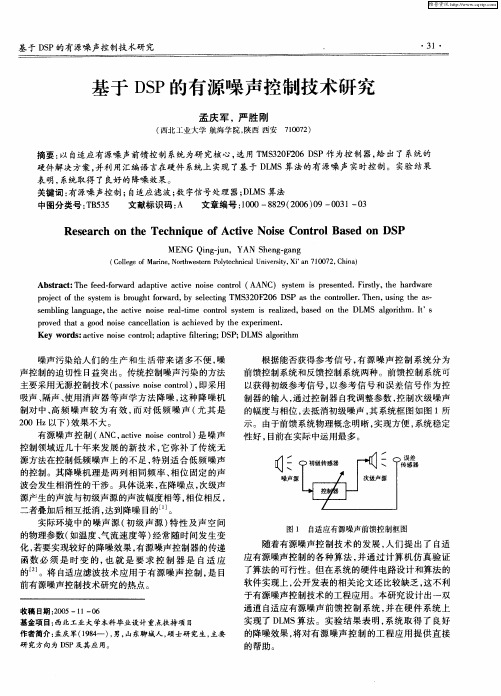
Re e r h o h c n q e o tv ie Co t o s d o P s a c n t e Te h i u fAc i e Nos n r lBa e n DS M N i - n A hn—ag E G Qn j ,Y S eggn gu N
f o eeo M r e N r w s r o t hia U i r t X’ l70 7 , hn) l g f ai , o h et nP l e n l nv sy ia 10 2 C ia C l n t e yc c e i, l
Abta tT efe — r ada a t eat en i o t l A N )ss m i pee t . i t ,h ad a src: h df w r d pi c v os cnr ( A C yt s rsne Fr l te hrw r e o v i e o e d sy e
表明, 系统取 得 了 良好 的 降噪 效果 。 关键词 : 有源噪声控制 ; 自适应滤波 ; 数字信号处理器; L S算法 DM 中图分 类号 :B 3 T 55 文献标 识 码 : A 文章 编 号 :00— 89 20 )9— 0 1 3 10 8 2 (0 6 0 0 ni ot1 , ps v o e n o) 即采用 i s c r 吸声 、 隔声 、 使用消声器等声学方法降噪 , 这种降 噪机 制对 中、 高频 噪声较 为有效 , 而对低 频 噪声 ( 其是 尤 20H 0 z以下 ) 果不 大 。 效 有源 噪声 控 制 ( N ateni ot 1 是 噪 声 A C,cv os cnr ) i e o 控制 领域 近几 十年 来 发 展 的新 技 术 , 弥补 了传 统 无 它 源方法在控制低频 噪声上 的不足 , 特别适合低频 噪声 的控制。其降噪机理是两列相 同频率 、 相位 固定 的声 波会发生相消性的干涉。具体说来 , 在降噪点 , 次级声 源产 生 的声 波与初 级 声源 的声 波 幅度 相 等 , 位相 反 , 相 二者 叠加 后相 互抵 消 , 到降 噪 目的 J 达 。
硕士毕业设计蓝牙耳机

硕士毕业设计蓝牙耳机蓝牙耳机在近年来的普及和发展中,成为了人们生活中不可或缺的一部分。
无线连接的便利性和音质的提升,使得蓝牙耳机在各个领域都有广泛的应用。
作为硕士毕业设计的选题,蓝牙耳机可以是一个有趣且具有挑战性的研究方向。
首先,我们可以从蓝牙耳机的技术原理入手,深入探讨其工作原理和传输方式。
蓝牙耳机通过蓝牙技术与音频源设备进行无线连接,实现音频的传输和接收。
我们可以研究蓝牙耳机的通信协议,了解其在数据传输方面的优势和限制。
同时,还可以探索蓝牙耳机在不同频段和距离下的性能表现,以及如何优化其连接稳定性和音质。
其次,我们可以关注蓝牙耳机在音频处理方面的创新和改进。
蓝牙耳机作为一种音频设备,其音质的好坏直接影响用户的听觉体验。
因此,我们可以研究蓝牙耳机的音频解码和放大技术,以提升其音质表现。
同时,还可以探索蓝牙耳机在降噪和环境音调节方面的技术创新,使用户在不同环境下都能享受到清晰、高质量的音乐和通话体验。
此外,蓝牙耳机的设计也是一个重要的研究方向。
我们可以从人机工程学的角度出发,研究蓝牙耳机的佩戴舒适性和稳定性。
通过对人耳形态和耳机设计的深入研究,可以设计出符合人体工程学原理的蓝牙耳机,提供更好的佩戴体验。
同时,还可以考虑蓝牙耳机的外观设计和材料选择,使其更加符合时尚潮流和用户的审美需求。
除了技术方面的研究,我们还可以关注蓝牙耳机在市场和消费者需求方面的发展趋势。
通过市场调研和用户需求分析,可以了解蓝牙耳机的市场潜力和发展方向。
同时,还可以研究蓝牙耳机在不同用户群体中的应用场景和需求差异,以满足不同用户的个性化需求。
最后,我们可以考虑蓝牙耳机在可持续发展方面的研究。
随着电子产品的普及和更新换代速度的加快,电子废弃物的处理已成为一个全球性的环境问题。
因此,我们可以研究蓝牙耳机的可持续设计和材料回收利用方案,以减少对环境的影响。
综上所述,硕士毕业设计的选题蓝牙耳机可以从多个角度进行研究。
无论是从技术原理、音频处理、设计创新、市场需求还是可持续发展方面,都有丰富的研究内容和挑战。
基于MATLAB语音信号处理去噪毕业设计论文

基于MATLAB语音信号处理去噪毕业设计论文语音信号在实际应用中通常不可避免地受到噪音的干扰,这使得语音信号的处理变得困难。
因此,在语音信号处理领域,去噪技术一直是一个热门的研究方向。
本文将介绍一种基于MATLAB的语音信号处理去噪方法的毕业设计论文。
本文的主要内容分为以下几个部分。
首先,介绍语音信号处理的背景和意义。
在现实生活中,由于外界环境和设备的限制,语音信号往往会受到各种噪音的污染,如背景噪音、电磁干扰等。
因此,开发一种有效的语音信号处理去噪方法具有重要的实际意义。
其次,介绍基于MATLAB的语音信号处理去噪方法。
本文将采用小波降噪方法对语音信号进行去噪处理。
首先,对输入的语音信号进行小波变换,将信号转换到小波域。
然后,通过对小波系数进行阈值处理,将噪声系数置零,从而实现去噪效果。
最后,通过逆小波变换将信号转换回时域,并输出去噪后的语音信号。
接下来,介绍实验设计和结果分析。
本文将使用MATLAB软件进行实验设计,并选取一组含有不同噪声干扰的语音信号进行测试。
通过对不同噪声信号进行处理,比较不同参数设置下的去噪效果,评估提出方法的性能。
最后,总结全文并展望未来的研究方向。
通过本次研究,我们可以看到基于MATLAB的语音信号处理去噪方法在去除噪音方面具有较好的效果,并具有很大的应用潜力。
然而,该方法仍然有改进的空间。
未来的研究可以在算法优化、参数选择和应用场景等方面进行深入研究,进一步提高语音信号处理去噪的效果和性能。
总的来说,本文介绍了一种基于MATLAB的语音信号处理去噪方法的毕业设计论文。
通过对实验结果的分析和对未来研究方向的展望,本文为从事语音信号处理领域的研究人员提供了一定的参考和启示。
有源降噪耳机的设计与实现
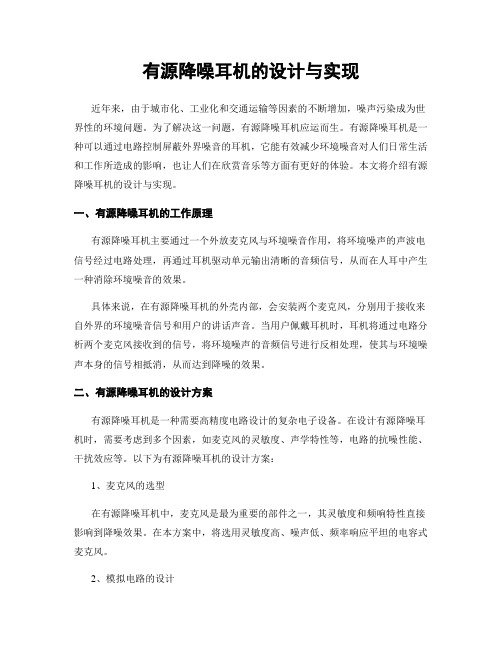
有源降噪耳机的设计与实现近年来,由于城市化、工业化和交通运输等因素的不断增加,噪声污染成为世界性的环境问题。
为了解决这一问题,有源降噪耳机应运而生。
有源降噪耳机是一种可以通过电路控制屏蔽外界噪音的耳机,它能有效减少环境噪音对人们日常生活和工作所造成的影响,也让人们在欣赏音乐等方面有更好的体验。
本文将介绍有源降噪耳机的设计与实现。
一、有源降噪耳机的工作原理有源降噪耳机主要通过一个外放麦克风与环境噪音作用,将环境噪声的声波电信号经过电路处理,再通过耳机驱动单元输出清晰的音频信号,从而在人耳中产生一种消除环境噪音的效果。
具体来说,在有源降噪耳机的外壳内部,会安装两个麦克风,分别用于接收来自外界的环境噪音信号和用户的讲话声音。
当用户佩戴耳机时,耳机将通过电路分析两个麦克风接收到的信号,将环境噪声的音频信号进行反相处理,使其与环境噪声本身的信号相抵消,从而达到降噪的效果。
二、有源降噪耳机的设计方案有源降噪耳机是一种需要高精度电路设计的复杂电子设备。
在设计有源降噪耳机时,需要考虑到多个因素,如麦克风的灵敏度、声学特性等,电路的抗噪性能、干扰效应等。
以下为有源降噪耳机的设计方案:1、麦克风的选型在有源降噪耳机中,麦克风是最为重要的部件之一,其灵敏度和频响特性直接影响到降噪效果。
在本方案中,将选用灵敏度高、噪声低、频率响应平坦的电容式麦克风。
2、模拟电路的设计有源降噪耳机的核心是模拟电路,它包括降噪电路和音频信号放大电路。
在本方案中,将采用反馈降噪电路,由运算放大器和分频滤波器构成。
电路的抗噪性能和滤波效果可以通过精心的参数设计得到提升。
3、数字电路的设计数字电路包括采样电路、数模转换电路和控制电路。
采用单片机以及相应的编程语言实现控制器,实现灵活、实时、准确控制,调节参数以获得良好效果。
三、有源降噪耳机的实现方法1、电路的打板制作和调试完成上述设计方案后,需要将电路打板制作。
将元器件布置并连接起来,使用示波器和信号源对整个电路进行实时调试和优化,以保证电路性能最优。
基于DSP的有源降噪系统的研究
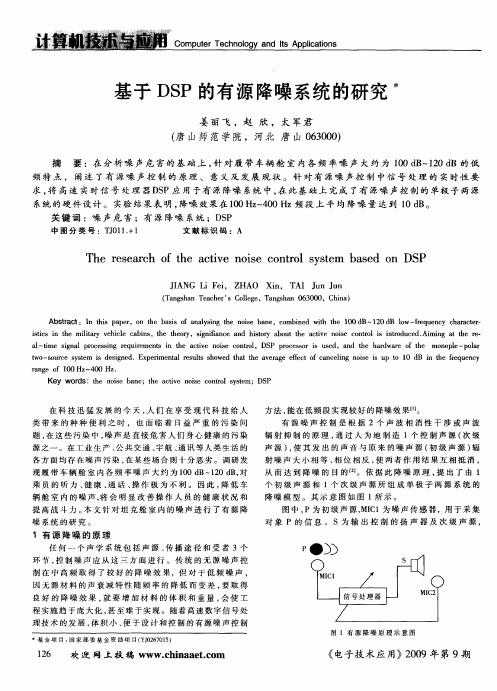
A t c :I h s p p r n t e b ss o n lsn h o s a e o i e i e 0 B一1 0d lw- r q e c h r ce — bsr t n t i a e ,o h a i f a ay ig t e n i b n ,c mb n d w t t 1 0 d a e hh 2 B o f u n y c a a tr e it s i h l a y v h ce c b n ,t e t e r ,sg i a c n itr b u h a t e n ie o t l i i t d c d. mi g a h e s c n t e mi tr e il a i s h h o i i y i nf n e a d h s y a o t t e ci o s c n r s n r u e Ai n t t e r - i o v o o a - i in l r c si g r q i me t n t e cie n ie c nr l lt me sg a p o e sn e u r e n s i h a t o s o to ,DS r c s o s u e ,a d h h r wae o h mo o l -p lr v P p o e s r i s d n t e a d r f t e n pe oa t -s u c y tm s d sg e wo o re s se i e in d.E p rme t lr s l h w d t a h v r g f c fc n e i g n ie i u o 0 d n t e fe u n y x e i n a e u t s o e h t t e a ea e e e t o a c l o s s p t 1 B i h r q e c s n
降噪耳机方案范文
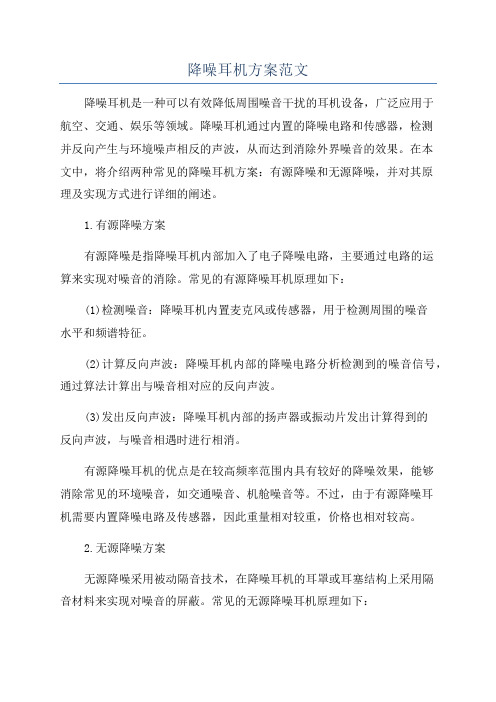
降噪耳机方案范文降噪耳机是一种可以有效降低周围噪音干扰的耳机设备,广泛应用于航空、交通、娱乐等领域。
降噪耳机通过内置的降噪电路和传感器,检测并反向产生与环境噪声相反的声波,从而达到消除外界噪音的效果。
在本文中,将介绍两种常见的降噪耳机方案:有源降噪和无源降噪,并对其原理及实现方式进行详细的阐述。
1.有源降噪方案有源降噪是指降噪耳机内部加入了电子降噪电路,主要通过电路的运算来实现对噪音的消除。
常见的有源降噪耳机原理如下:(1)检测噪音:降噪耳机内置麦克风或传感器,用于检测周围的噪音水平和频谱特征。
(2)计算反向声波:降噪耳机内部的降噪电路分析检测到的噪音信号,通过算法计算出与噪音相对应的反向声波。
(3)发出反向声波:降噪耳机内部的扬声器或振动片发出计算得到的反向声波,与噪音相遇时进行相消。
有源降噪耳机的优点是在较高频率范围内具有较好的降噪效果,能够消除常见的环境噪音,如交通噪音、机舱噪音等。
不过,由于有源降噪耳机需要内置降噪电路及传感器,因此重量相对较重,价格也相对较高。
2.无源降噪方案无源降噪采用被动隔音技术,在降噪耳机的耳罩或耳塞结构上采用隔音材料来实现对噪音的屏蔽。
常见的无源降噪耳机原理如下:(1)隔音材料:在降噪耳机的耳罩或耳塞结构上采用吸音材料或隔音海绵等材料,能够有效屏蔽外界噪音的传播。
(2)密闭设计:降噪耳机的耳罩或耳塞采用密闭设计,能够减少外界噪音进入耳机腔体的可能。
(3)选择合适耳塞:无源降噪耳机中的耳塞以及耳罩的合适与否对降噪效果至关重要,通过合适的耳塞或耳罩能够更好地与耳道贴合,屏蔽外界噪音的进入。
无源降噪耳机的优点是结构简单,重量轻,适合长时间佩戴,并且相对更加经济实惠。
然而,无源降噪的效果主要集中在低频范围内,对于高频噪音效果不明显。
综上所述,有源降噪耳机和无源降噪耳机是两种常见的降噪耳机方案。
有源降噪通过内置的降噪电路和传感器,能够在较高频率范围内实现较好的降噪效果,但价格相对较高。
有源降噪耳机方案工程

有源降噪耳机方案工程摘要:有源降噪耳机是一种能够主动抵消外部环境噪音的耳机,能够提供用户清晰的音乐和通话体验。
本文将介绍有源降噪耳机的工作原理、设计方案、测试和优化,并对未来的发展趋势进行展望。
引言:噪音污染是现代社会面临的一个严重问题,尤其是在拥挤的城市生活中。
长时间暴露在噪音环境中会对人的身心健康产生负面影响,因此,有源降噪耳机的出现成为了一种解决噪音问题的有效方式。
有源降噪耳机通过内置的传感器和电子元件,能够主动识别并抵消外部环境噪音,给用户带来清晰的音乐和通话体验。
本文将针对有源降噪耳机的工程方案进行详细介绍,包括设计原理、组成部分、测试方法和优化方案。
希望通过本文的介绍,读者能够对有源降噪耳机有一个更深入的了解,并对未来的发展趋势有所把握。
一、有源降噪耳机的工作原理有源降噪耳机主要通过两种方式来消除外部环境噪音,即通过外部传感器和内部电路的联合作用。
当外部传感器检测到环境噪音时,内部电路会产生一个与噪音相反的声波信号,从而实现抵消效果。
有源降噪耳机的工作原理如下:1. 外部传感器检测噪音:有源降噪耳机内部配备了多个传感器,可以实时监测外部环境的噪音水平。
2. 内部电路产生反向声波:一旦传感器检测到噪音,内部的电子电路会立即产生一个与噪音相反的声波信号,通过耳机扬声器发出。
3. 抵消效果:外部噪音和内部产生的声波信号相互抵消,使得外部噪音对用户的影响大大减弱。
二、有源降噪耳机的设计方案有源降噪耳机的设计方案主要包括传感器选择、电路设计、驱动单元和电源管理等部分。
下面将对每个部分的设计方案进行详细介绍。
1. 传感器选择:有源降噪耳机需要内置多个传感器,用于监测环境的噪音水平。
一般来说,可以选择MEMS传感器、电容传感器和压电传感器等。
这些传感器在灵敏度和功耗上有所不同,需要根据实际需求进行选择。
2. 电路设计:有源降噪耳机的电路设计是整个系统中最核心部分。
电路需要包括信号处理模块、数字信号处理器(DSP)、放大器和滤波器等,用于实时处理传感器采集的噪音信号,并产生相反的声波信号。
基于有源消声的隔声系统研究的开题报告

基于有源消声的隔声系统研究的开题报告一、研究背景及意义隔声系统是现代建筑物中必不可少的一部分,其主要作用是通过隔音材料和结构设计来降低建筑物内外的声音传输。
但是,这种传统的隔声系统仍然存在一些缺陷。
例如,它只能在特定频率下发挥最佳效果,而导致噪声污染的频率范围往往非常广泛,因此传统的隔声系统难以完全解决这个问题。
有源消声技术是可以解决这个问题的一种新兴技术,它通过在隔声系统中嵌入麦克风和扬声器,对建筑物内外的声音进行实时测量和修正。
在该系统中,扬声器通过发出与外界噪音相反的声音波来抵消噪音的传播,从而实现更好的隔音效果。
有源消声隔音系统的研究对于建立更为安静、舒适的室内环境至关重要。
此技术应用范围广泛,不仅可以用于噪音污染较为严重的城市,还可以用于传统的隔声系统无法完全解决的行业,如航空、汽车、工厂等领域。
因此,本研究将探索有源消声技术在隔声系统中的应用,并研究其隔音效果和优化策略。
二、研究内容1. 系统介绍:介绍隔声系统的原理和有源消声技术的基本概念和原理。
2. 实验设计:设计具有不同参数的有源消声隔声系统,分别测试它们的隔音效果,并比较它们的性能。
3. 数值模拟:通过数值模拟的方法,在计算机上模拟有源消声隔声系统的工作过程,并对系统参数进行优化。
4. 实验结果和分析:对实验结果进行综合分析,找出有源消声隔声系统的优势和局限性,并提出针对应用需求的优化策略。
三、研究方法1. 理论分析:对隔声系统的相关理论进行分析和研究,从而解释有源消声技术在隔声系统中的应用原理。
2. 实验研究:在实验室中搭建有源消声隔声系统,通过测量声音传输特性和实时反馈输入到系统,研究不同参数有源消声隔声系统的隔声效果。
3. 数值模拟:通过MATLAB等数学软件,建立有源消声隔声系统的数学模型,模拟其工作原理,进行优化设计。
四、预期贡献本研究的预期成果包括:1. 探索有源消声隔声系统在隔声领域中的应用,提出其中存在的优势和局限性,为该技术在更广泛领域的应用提供基础研究支持。
图像降噪技术研究背景及意义毕业论文
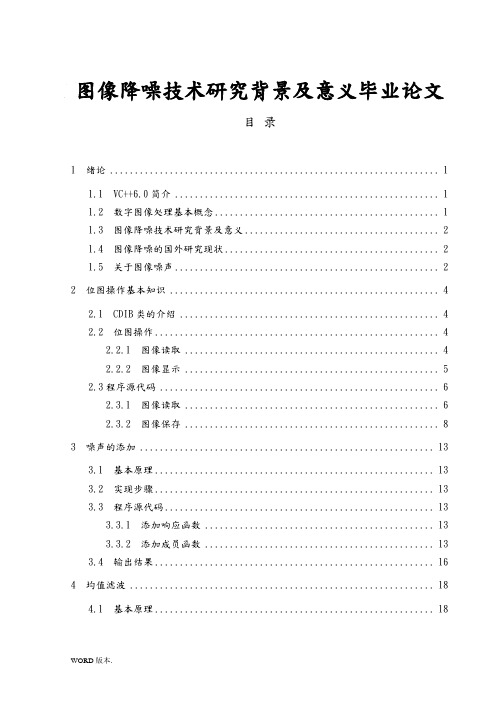
图像降噪技术研究背景及意义毕业论文目录1 绪论 (1)1.1 VC++6.0简介 (1)1.2 数字图像处理基本概念 (1)1.3 图像降噪技术研究背景及意义 (2)1.4 图像降噪的国外研究现状 (2)1.5 关于图像噪声 (2)2 位图操作基本知识 (4)2.1 CDIB类的介绍 (4)2.2 位图操作 (4)2.2.1 图像读取 (4)2.2.2 图像显示 (5)2.3程序源代码 (6)2.3.1 图像读取 (6)2.3.2 图像保存 (8)3 噪声的添加 (13)3.1 基本原理 (13)3.2 实现步骤 (13)3.3 程序源代码 (13)3.3.1 添加响应函数 (13)3.3.2 添加成员函数 (13)3.4 输出结果 (16)4 均值滤波 (18)4.1 基本原理 (18)4.2 实现方法 (18)4.3 程序源代码 (20)4.3.1 添加响应函数 (20)4.3.2 添加成员函数 (21)4.4 结果输出及分析 (24)4.4.1 结果输出 (24)4.4.2 结果分析 (25)5 中值滤波 (26)5.1 基本原理 (26)5.2 实现方法 (26)5.3 程序源代码 (26)5.3.1 添加响应函数 (26)5.3.2 添加成员函数 (27)5.4结果输出及分析 (32)5.4.1结果输出 (32)5.4.2结果分析 (33)6 傅立叶降噪 (34)6.1 基本概念 (34)6.1.1 二维傅里叶变换 (34)6.1.2 二维离散傅里叶变换 (34)6.1.3 快速傅里叶变换 (35)6.2 相关原理 (35)6.3 程序源代码 (36)6.3.1 快速傅里叶变换 (36)6.3.2快速傅里叶逆变换 (38)6.3.3低通滤波 (40)6.4 结果输出及分析 (44)6.4.1 结果输出 (44)6.4.2结果分析 (46)7 小波降噪 (47)7.1 基本概念 (47)7.1.1 二维离散小波变换 (47)7.2.2 Mallat算法 (48)7.2 相关原理 (49)7.3 程序源代码 (50)7.3.1 LPass_Filter函数 (52)7.3.2 HPass_Filter函数 (54)7.3.3 DWT_Inverse函数 (55)7.4 结果输出及分析 (56)7.4.1 结果输出 (56)7.4.2 结果分析 (59)结论 (60)致谢 (61)参考文献 (62)附录A 英文原文 (63)附录B 中文翻译 (76)1 绪论1.1 VC++6.0简介VC++6.0是Microsoft公司推出的一个基于Windows系统平台、可视化的集成开发环境,它的源程序按C++语言的要求编写,并加入了微软提供的功能强大的MFC(Microsoft Foundation Class)类库。
(完整版)图像处理本科毕业设计
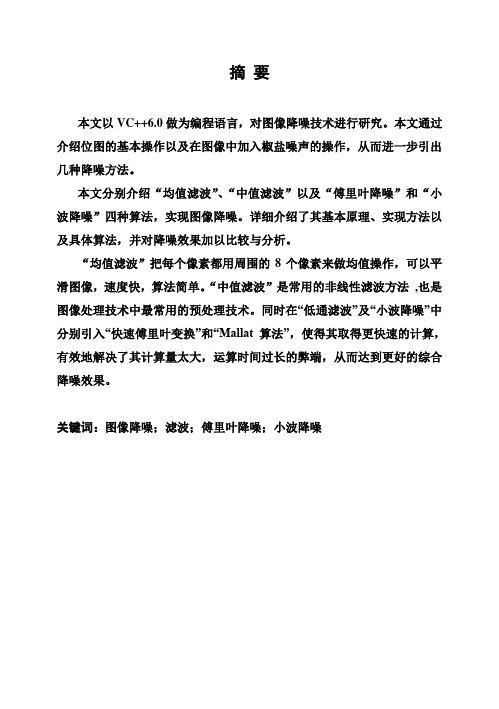
摘要本文以VC++6.0做为编程语言,对图像降噪技术进行研究。
本文通过介绍位图的基本操作以及在图像中加入椒盐噪声的操作,从而进一步引出几种降噪方法。
本文分别介绍“均值滤波”、“中值滤波”以及“傅里叶降噪”和“小波降噪”四种算法,实现图像降噪。
详细介绍了其基本原理、实现方法以及具体算法,并对降噪效果加以比较与分析。
“均值滤波”把每个像素都用周围的8个像素来做均值操作,可以平滑图像,速度快,算法简单。
“中值滤波”是常用的非线性滤波方法,也是图像处理技术中最常用的预处理技术。
同时在“低通滤波”及“小波降噪”中分别引入“快速傅里叶变换”和“Mallat 算法”,使得其取得更快速的计算,有效地解决了其计算量太大,运算时间过长的弊端,从而达到更好的综合降噪效果。
关键词:图像降噪;滤波;傅里叶降噪;小波降噪AbstractTaking VC++6.0 as the programming language, this paper is a study about image noise reduction technology. Furthermore, introducing several noise reducing measures through the introduction of the basic processing and the operation to put the salt and pepper noise into the image.The paper introduces Averaging Filter, Median Filter,Fourier Lowpass Filtering and Wavelet Filter to achieve image noise reducing. Here we introduce the basic principles, implement methods, detailed arithmetic, and make comparison and analysis the noise reducing effects.Averaging Filter operates every pixel by using 8 pixels meanly. It can make the images smoothing, fast and easy to calculate. Median Filter Fourier is a common nonlinear filtering way and also common preprocessing technique when processing images. Introducing FFT and Mallat Algorithm separately into Lowpass Filtering and Wavelet Filter, and then we can make faster calculating and solve the massive calculating more efficiently. Therefore, we can have a more effective noise reducing.Keywords:Image Noise Reduction;Filter;Fourier Filter;Wavelet filter毕业设计(论文)原创性声明和使用授权说明原创性声明本人郑重承诺:所呈交的毕业设计(论文),是我个人在指导教师的指导下进行的研究工作及取得的成果。
图像去噪的基本原理、典型方法和最新方法 电子技术专业毕业设计 毕业论

摘要数字图像在其形成、传输和记录的过程中,由于成像系统、传输介质和记录设备的不完善往往使得获取的图像受到多种噪声的污染。
因此在模式识别、计算机视觉、图像分析和视频编码等领域,噪声图像的前期处理极其重要,其处理效果的好坏将直接影响到后续工作的质量和结果。
本文主要介绍图像去噪的基本原理、典型方法和最新方法。
考虑到图像去噪技术的飞速发展,本文在论述其基本理论的同时还着重介绍近年来国内有关的最新研究成果和最新方法。
本文被分成四个部分。
第一部分是绪论,论述图像去噪发展趋势及研究图像去噪的理由与意义。
第二部分论述中值滤波法和自适应平滑滤波法的基本原理,完成基于matlab中值滤波的代码实现,并对其结果进行分析。
本文提出两种新的算法,即中值滤波的改进算法即自适应加权算法,和自适应平滑滤波的改进算法。
并且也得出这两种算法的仿真结果,并且对结果进行分析。
第三部分首先论述基于频域的图像去噪方法的基本原理,然后本文对巴特沃斯低通滤波和巴特沃斯高通滤波的基本原理作了论述,并且分别完成基于matlab的巴特沃斯低通滤波和高通滤波的代码实现,对结果进行分析。
同时对程序中的重要语句分别作注释。
第四部分是本文最重要的一章,重点阐述基于小波域的两种图像去噪方法和算法,即小波阈值去噪法与小波维纳滤波去噪法。
在小波阈值去噪法中,本文重点论述小波阈值去噪的三个步骤,并介绍传统经典的阈值化方法即软阈值法、硬阈值法以及四种确定阈值的方法。
其中包括统一阈值法、基于零均值正态分布的置信区间阈值、最小最大阈值法和理想阈值估计法,并且完成小波阈值去噪法的代码实现,将小波阈值去噪法的去噪结果和中值滤波法的去噪结果进行比较分析,得出结论。
在小波维纳滤波去噪法中本文着重论述小波维纳滤波去噪法的基本原理,得到小波维纳滤波去噪法的仿真结果,并且将波维纳滤波去噪法的结果与维纳滤波去噪法的结果进行对比分析。
关键词:图像去噪,维纳滤波,中值滤波,小波变换,阈值AbstractIn its formation, transmission and recording of the process of digital images, because imaging system , transmission media and recording equipment are often imperfect, the obtained images are polluted by a variety of noises. In pattern recognition, computer vision, image analysis and video coding and other fields,noise image pre-processing is extremely important and whether its effect is good or bad will have a direct impact on the following quality and results. This paper introduces the basic principle, the typical method and the latest methods of image denoising.Taking the rapid development of technology of image denoising into account, the paper discusses the basic theory and at the same time also the latest research results and the latest methods in recent years.This paper is divided into four parts.introduction The first part is the introduction and discusses development trend of image denoising and the reasons and significance of studying image denoising. The second part, deals with the basic principles of median filter and adaptive smoothing filter, achieves the completion of median filtering code based on Matlab, and analyzes the results. This paper presents two new algorithm, which is the improved algorithms of the filtering called adaptive weighted algorithm, and the improved algorithm of adaptive smoothing. And the paper has reached this algorithm simulation results, and analyzed the results. The third part firstly discusses the basic principles of image denoising based on frequency domain . Then this paper discusses the basic principles of Butterworth low-pass filter and Butterworth high-pass filtering, and completes the code achieved based on Matlab Butterworth low-pass filter and high-pass filtering and analyzes the results. Meanwhile important statements of the procedures are explained. The fourth part of this article is the most important chapter and focuses on the two methods and algorithms of image denoising based on wavelet domain, which are the wavelet domain thresholding method and wavelet wiener filter method. In wavelet thresholding method, the paper focuses on the three steps of wavelet thresholding and discusses the traditional classical threshold methods,which are soft, and the threshold hard threshold law, and introduces four ways of determining the threshold.The four ways include a single threshold value, intervalthreshold based on the zero mean normal confidence, the largest minimum threshold value and ideal threshold estimates.The paper completes achieving code of wavelet thresholding method and comparatively analyzes the results of wavelet thresholding method and the results of denoising filter method. In wavelet wiener filter ,the paper method focuses on the basic principle of wavelet wiener filter, achieves simulation results of wavelet wiener filter method, and compares the results of wavelet wiener filter method with the results of the wiener filter method.Keywords : image denoising, Wiener filter, filtering, wavelet transform, threshold第1章绪论1.1 图像去噪的发展趋势图像信号处理中最困难的问题之一是:怎样滤出图像中的噪声而又不模糊图像的特征及边缘。
盾构毕业设计基于声学控制的隧道噪声减少方案
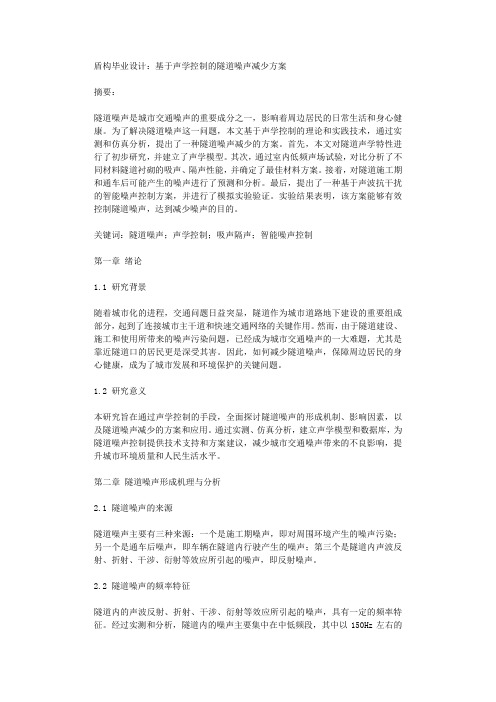
盾构毕业设计:基于声学控制的隧道噪声减少方案摘要:隧道噪声是城市交通噪声的重要成分之一,影响着周边居民的日常生活和身心健康。
为了解决隧道噪声这一问题,本文基于声学控制的理论和实践技术,通过实测和仿真分析,提出了一种隧道噪声减少的方案。
首先,本文对隧道声学特性进行了初步研究,并建立了声学模型。
其次,通过室内低频声场试验,对比分析了不同材料隧道衬砌的吸声、隔声性能,并确定了最佳材料方案。
接着,对隧道施工期和通车后可能产生的噪声进行了预测和分析。
最后,提出了一种基于声波抗干扰的智能噪声控制方案,并进行了模拟实验验证。
实验结果表明,该方案能够有效控制隧道噪声,达到减少噪声的目的。
关键词:隧道噪声;声学控制;吸声隔声;智能噪声控制第一章绪论1.1 研究背景随着城市化的进程,交通问题日益突显,隧道作为城市道路地下建设的重要组成部分,起到了连接城市主干道和快速交通网络的关键作用。
然而,由于隧道建设、施工和使用所带来的噪声污染问题,已经成为城市交通噪声的一大难题,尤其是靠近隧道口的居民更是深受其害。
因此,如何减少隧道噪声,保障周边居民的身心健康,成为了城市发展和环境保护的关键问题。
1.2 研究意义本研究旨在通过声学控制的手段,全面探讨隧道噪声的形成机制、影响因素,以及隧道噪声减少的方案和应用。
通过实测、仿真分析,建立声学模型和数据库,为隧道噪声控制提供技术支持和方案建议,减少城市交通噪声带来的不良影响,提升城市环境质量和人民生活水平。
第二章隧道噪声形成机理与分析2.1 隧道噪声的来源隧道噪声主要有三种来源:一个是施工期噪声,即对周围环境产生的噪声污染;另一个是通车后噪声,即车辆在隧道内行驶产生的噪声;第三个是隧道内声波反射、折射、干涉、衍射等效应所引起的噪声,即反射噪声。
2.2 隧道噪声的频率特征隧道内的声波反射、折射、干涉、衍射等效应所引起的噪声,具有一定的频率特征。
经过实测和分析,隧道内的噪声主要集中在中低频段,其中以150Hz左右的低频噪声为主,而高频噪声则相对较弱。
机制专业毕业设计例文
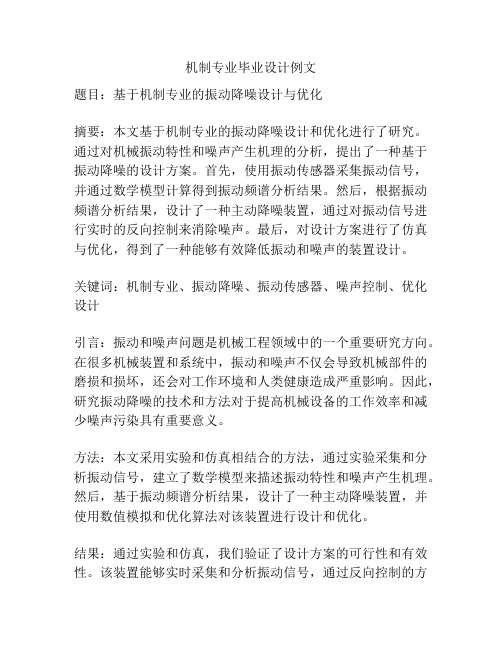
机制专业毕业设计例文题目:基于机制专业的振动降噪设计与优化摘要:本文基于机制专业的振动降噪设计和优化进行了研究。
通过对机械振动特性和噪声产生机理的分析,提出了一种基于振动降噪的设计方案。
首先,使用振动传感器采集振动信号,并通过数学模型计算得到振动频谱分析结果。
然后,根据振动频谱分析结果,设计了一种主动降噪装置,通过对振动信号进行实时的反向控制来消除噪声。
最后,对设计方案进行了仿真与优化,得到了一种能够有效降低振动和噪声的装置设计。
关键词:机制专业、振动降噪、振动传感器、噪声控制、优化设计引言:振动和噪声问题是机械工程领域中的一个重要研究方向。
在很多机械装置和系统中,振动和噪声不仅会导致机械部件的磨损和损坏,还会对工作环境和人类健康造成严重影响。
因此,研究振动降噪的技术和方法对于提高机械设备的工作效率和减少噪声污染具有重要意义。
方法:本文采用实验和仿真相结合的方法,通过实验采集和分析振动信号,建立了数学模型来描述振动特性和噪声产生机理。
然后,基于振动频谱分析结果,设计了一种主动降噪装置,并使用数值模拟和优化算法对该装置进行设计和优化。
结果:通过实验和仿真,我们验证了设计方案的可行性和有效性。
该装置能够实时采集和分析振动信号,通过反向控制的方式消除噪声,并降低振动幅值。
实验结果表明,在装置的工作状态下,振动幅值和噪声水平较之前有显著降低。
结论:本文基于机制专业的振动降噪设计和优化研究,提出了一种通过实时反向控制来消除噪声的装置设计方案。
实验和仿真结果表明,该装置能够有效降低振动和噪声的水平,并具有实际应用价值。
进一步的研究可以考虑对装置进行更为精细的优化和改进,以进一步提高降噪效果和性能。
毕业设计--基于双边滤波的图像去噪的方法

. . . . .学号:1008431110(2014届)基于双边滤波的图像去噪方法院系电子信息工程学院专业通息工程姓名指导教师讲师2014年4月摘要双边滤波是非线性的滤波方法,是结合图像的像素值相似度空间邻近度和空间领近度的一种折衷处理,同时考虑灰度相似性和空域信息,达到保边去噪的目的。
双边滤波具有简单、非迭代、局部的特点。
双边滤波器的好处是可以做边缘保存,一般过去用的维纳滤波或者高斯滤波去降噪,都会较明显地模糊边缘,对于高频细节的保护效果并不明显。
双边滤波比高斯滤波多了一个高斯方差,它是基于空间分布的高斯滤波函数,所以在边缘附近,离的较远的像素不会影响到边缘上的像素值,这样就保证了边缘附近像素值的保存。
但是由于保存了过多的高频信息对于彩色图像里的高频噪声,双边滤波器不能够彻底的滤掉,只能够对于低频信息进行较好的滤波。
其具体的操作方法有两个,第一个是高斯模版,用个模板对图像中的每一个像素值进行扫描,然后把某一点和其邻域像素的加权平均值代替那一个中心的值高斯滤波器是根据高斯函数的形状来选择其权值的线性平滑滤波器,高斯滤波是线性平滑滤波的一种,最适合去除的噪声类型是服从正态分布的噪声。
第二个是以灰度级的差值作为函数系数生成的模板。
然后这两个模板点乘就得到了最终的双边滤波模板,最后得到双边滤波处理后的图像。
关键词:图像;去噪;双边滤波;高斯滤波AbstractThe bilateral filter is a nonlinear filtering method, is the combination of image pixel value similarity space proximity and space brought a compromise approach degree, considering the gray similarity and spatial information, to achieve the purpose of edge preserving denoising. The bilateral filter has the advantages of simple, non iterative, local. The bilateral filter is good to do edge preservation,generally used Wiener filtering or Gauss filter to denoise, will obviously fuzzy edge, for the protection of high frequency detail is not obvious. Bilateral filtering than Gauss filter has a Gauss variance, it is Gauss filter function based on the spatial distribution, so near the edge, the pixel will not affect the farther to the pixel on the edge of the value, thus ensuring the preservation of edge pixel values. But because of the high frequency information saved too much for the high frequency noise in the color image, the bilateral filter can not be completely filtered out, can only be better filtering for the low frequency information. The specific operation method has two, the first is Gauss template, scanning for each pixel in the image with a template, and then the weighted one point and its neighborhood pixels instead of the average value of a central value Gauss filters are linear smoothing filter to select the weights based on the Gauss function the shape, the Gauss filter is a linear smoothing filter for noise removal, the type is subject to normally distributed noise. The second is the difference of gray level as function coefficients generated templates. Then the two template dot get bilateral filtering template final, finally get the image after bilateral filtering.Key words: Image ;Denoising;Bilateral Filtering;Gauss Filtering目录摘要 (I)ABSTRACT................................................................................................. I I 1 引言 .. (1)1.1 课题的研究背景及意义 (1)1.2 国外研究现状 (1)1.3 图像噪声及图像去噪方法 (2)1.4 图像质量评价方法 (4)1.5论文研究目标及结构安排 (7)2 双边滤波理论 (7)2.1双边滤波定义 (7)2.2双边滤波器的设计 (7)3 图像去噪的方法 (9)3.1 中值滤波介绍 (9)3.2 高斯滤波介绍 (11)4 双边滤波实验结果 (13)4.1结果图片 (13)5 论文总结 (18)参考文献 (19)1 引言1.1 课题的研究背景及意义当今社会已经进入了一个高度信息化的阶段,人们对信息的需求越来越多。
压缩机振动噪声测试分析与降噪设计毕业论文

压缩机振动噪声测试分析与降噪设计毕业论文目录摘要 ........................................... 错误!未定义书签。
Abstract ........................................... 错误!未定义书签。
目录 (I)第一章绪论 (1)1.1课题研究背景 (1)1.2噪声治理目的、意义 (1)1.3 国外研究现状及趋势 (2)1.4 课题研究容 (3)第二章螺杆压缩机的噪声分析 (3)2.1螺杆压缩机的工作原理 (4)2.2噪声来源 (5)2.2.1机械噪声 (5)2.2.2 空气动力性噪声 (5)2.2.3电磁噪声 (7)第三章喷油螺杆压缩机的主体结构设计 (9)3.1主机结构设计 (9)3.2主要零部件设计和选型 (9)第四章螺杆压缩机减振降噪分析与设计 (13)4.1减振降噪方法概述 (13)4.2吸声控制 (13)4.2.1吸声材料 (14)4.2.2吸声结构 (16)4.3隔声控制及隔声罩的设计 (20)4.3.1隔声性能评价 (20)4.3.2隔声结构和特性研究 (21)4.3.3设计隔声罩的要点 (24)4.4消声控制及消声器的设计 (25)4.4.1声学性能的评价量 (25)4.4.2消声器的种类 (26)4.4.3消声器设计中的几个问题 (27)4.4.4消声器设计的四个原则 (28)第五章螺杆压缩机振动噪声控制系统的效果分析 (30)5.1测点布置及测量数据 (30)5.2 噪声控制 (31)5.3结构理论插入损失 (33)5.4噪声控制效果 (33)第六章结论 (35)参考文献 (36)致谢 (37)第一章绪论1.1课题研究背景目前, 噪声已被视为严重污染之一。
随着现代工业的发展,对于工业噪声的控制越来越重要。
工业噪声一般是指在工业生产过程中,由于机械设备运转而发出的声响。
螺杆压缩机作为一种强噪声设备, 对环境污染严重, 其整个机组噪声值高达90-110 dB( A ), 涉及面广,传播距离远,影响较大,严重危害工人的工作环境和身心健康。
降噪工程设计施工(3篇)

第1篇一、降噪工程设计1. 噪音源分析:在降噪工程设计前,首先需要对噪音源进行详细分析,包括噪音类型、强度、频率等,以便确定降噪目标。
2. 噪音传播途径分析:了解噪音在传播过程中的途径,如空气传播、固体传播等,为降噪设计提供依据。
3. 降噪目标确定:根据噪音源分析和噪音传播途径分析,确定降噪目标,如降低噪音强度、减少噪音传播距离等。
4. 降噪方案设计:根据降噪目标,设计合理的降噪方案,包括隔声、吸声、消声、减振等手段。
5. 降噪材料选择:根据降噪方案,选择合适的降噪材料,如隔音板、吸声材料、消声材料等。
6. 降噪系统设计:设计合理的降噪系统,包括降噪设备的安装、布局、连接等。
二、降噪工程施工1. 施工准备:根据降噪工程设计,准备施工所需材料、设备、工具等。
2. 施工现场布置:按照设计要求,合理布置施工现场,确保施工顺利进行。
3. 隔声施工:按照隔声设计方案,安装隔音板、隔音墙等隔声设施,降低噪音传播。
4. 吸声施工:按照吸声设计方案,安装吸声材料,降低噪音反射和传播。
5. 消声施工:按照消声设计方案,安装消声器、消声管道等消声设施,降低噪音排放。
6. 减振施工:按照减振设计方案,安装减振器、减振垫等减振设施,降低噪音振动。
7. 系统调试:完成降噪设施安装后,进行系统调试,确保降噪效果达到预期目标。
8. 施工验收:根据降噪工程设计要求,对施工完成的降噪设施进行验收,确保工程质量。
三、降噪工程后期维护1. 定期检查:对降噪设施进行定期检查,发现问题及时维修,确保降噪效果。
2. 设备维护:对降噪设备进行定期维护,延长设备使用寿命,保证降噪效果。
3. 环境监测:对降噪工程实施后的声环境进行监测,确保降噪效果达到预期目标。
4. 优化调整:根据监测结果,对降噪工程进行优化调整,进一步提高降噪效果。
总之,降噪工程设计施工是一项复杂的技术活动,需要综合考虑噪音源、传播途径、降噪目标等因素,通过合理的方案设计和施工,有效降低噪音污染,改善声环境。
- 1、下载文档前请自行甄别文档内容的完整性,平台不提供额外的编辑、内容补充、找答案等附加服务。
- 2、"仅部分预览"的文档,不可在线预览部分如存在完整性等问题,可反馈申请退款(可完整预览的文档不适用该条件!)。
- 3、如文档侵犯您的权益,请联系客服反馈,我们会尽快为您处理(人工客服工作时间:9:00-18:30)。
2008届毕业设计(论文) 论文题目:有源降噪研究学院: 信息与电子工程学院专业: 电子信息工程班级: 2004级041班学号:学生姓名: 曹玲瑛指导教师: 施祥二○○八年六月摘要本论文主要通过三种不同的调控方式对中低频占主导地位的噪声进行频域上的调控(直接对原始噪声的某些频段进行调控;在原始噪声的基础上加入实际噪声),并通过成对比较法比较了不同调控方法和调控强度调控后噪声的主观烦恼变化情况;还有通过有源消声调控(直接对原始噪声加入反相器)。
结果表明:所有调控方法在5种不同调控强度下主观烦恼排序基本一致,强度越强,烦恼度越高;在原始噪声中加入较低频率成分比加入较高频率成分更烦恼;加入自然背景声总体上比添加其他成分烦恼度更低。
加入反相器后,明显消声。
研究结果给主要通过改变噪声的频域特性来改善人们对噪声的主观感觉提供了研究基础。
关键词:声调控,频域,主观烦恼ABSTRACTThis paper mainly regulated and controlled the frequency for dominant low-frequency noise through three kinds of different methods (regulating and controlling some of the original band directly; adding noise on the basis of the actual noise in the original noise), and adopted into Compared to the comparison of different control methods and control the intensity of the noise after changes in the subjective annoyance; Active Noise Control was also available method (directly by adding inverse noise of the original). The results showed that all-control methods were basically the same sort of subjective annoyance under five different intensity control, the more strength, the higher the degree of trouble. Adding noise in the low frequency components was more trouble than adding noise in the higher frequency components; on the whole adding the natural background sound was lower than adding other ingredients annoyance. By adding the inverter is obviously silence. The results primarily provided a research base to improve people's subjective sense through changing the noise frequency.Keywords: Voice control, frequency-domain, subjective annoyance目录摘要................................................................................................................................... I ABSTRACT.......................................................................................................................... I I 引言.. (1)第1章有源降噪的研究情况 (2)1.1国内外研究状况 (2)1.1.1传统的噪声控制技术 (2)1.1.2 噪声控制的新技术——有源控制 (4)1.2本课题及论文的研究内容 (5)1.2.1 本课题的研究内容 (5)1.2.2 本论文的研究内容 (6)1.2.3 拟解决的的关键问题 (6)第2章有源降噪的调控方法 (7)2.1实验概述 (7)2.2实验软件 (8)2.2.1声望软件 (8)2.2.2 cool edit pro2.0软件 (9)2.2.3 origin软件 (9)2.3频域上的调控 (10)2.3.1 实验过程 (10)2.3.2 实验结果 (14)2.4自然声的叠加 (16)2.4.1 实验过程 (16)2.4.2 实验结果 (16)2.5反相器的应用 (17)2.5.1 实验过程 (17)2.5.2 小结 (18)2.6本章小结 (18)第3章结论 (20)3.1本论文的主要结论 (20)3.2需进一步研究的问题 (20)3.3展望 (20)致谢 (22)参考文献 (23)引言噪声对人的影响是多方面的,主要包括心理和生理影响,其中心理影响是受体的一种主观感觉,主要表现为烦恼和不愉悦,在长期受噪声干扰环境中工作和生活的人,多有烦躁、失眠、耳鸣、头痛、多梦、疲劳无力、记忆力衰退等症状[1,2]。
而现代社会尤其是城市中的噪声污染非常普遍,不仅受影响人口多,而且由于其影响比较直接,公众对它的关注度也越来越高[3,4,5]。
传统的噪声污染控制控制主要通过降低噪声级来减少其影响,在声学工作者的努力下,设备和环境辐射的噪声境研究的深入,我们越来越发现单纯降低噪声级的做法是有限的而且是不够的,由于原有噪声的时域和频域特性被随意改变,人们对受控制后噪声的主观感觉有时并没有得到改善甚至变得更烦恼或更不愉快。
因此,在降低声源和环境噪声的同时,我们应该有意识地控制设备或环境噪声的时域和频域特性,通过对噪声在时域或频域上的调节和平衡及环境噪声所处声场景的合理布置等,改善人们对噪声的主观感觉,开展有关声调控技术研究是实现这一设想的基础。
换言之,在掌握了具体使噪声听起来变得更愉悦的声调控技术之后,我们就可以在声源识别基础上,结合具体噪声控制技术的运用对不同频率的噪声进行提升或衰减,使设备排放的噪声听起来比较愉悦;可以结合特定的环境噪声,用过有源消声和隔声等技术的合理应用,设计有关电子耳塞,使受声者接收到的环境噪声变成舒适的声学环境等。
第1章有源降噪的研究情况1.1 国内外研究状况目前国内外对声主观感觉的研究,主要侧重于声景观、声品质和噪声主观烦平衡。
从这个认识点出发来看噪声,可以认为噪声是一种失去平衡的声景观[14]。
从环境噪声的控制技术上讲,对声源进行控制所采取的措施主要有二类,一是改进机械或设备的结构以降低声源的噪声发射功率,二是采取吸声、隔声、减振、隔振以及安装消声器等方法以控制噪声源的噪声辐射[15]。
1.1.1 传统的噪声控制技术声学系统一般是由声源、传播途径和接收器三环节组成的,即声源传播途径接收器对于所需要的声音,必须为它的产生、传播和接收提供良好的条件。
对于噪声,则必须设法抑制它的产生、传播和对听者的干扰,根据上述三环节,分别采取措施。
在声源处抑制噪声:这是最根本的措施,包括降低激发力,减小系统各环节对激发力的响应以及改变操作程序或改造工艺过程等。
在声传播途径中的控制:这是噪声控制中的普遍技术,包括隔声、吸声、隔振,阻抗失配等措施。
接收器的保护措施:在某些情况下,噪声特别强烈,在采用上述措施后,仍不能达到要求,或者工作过程中不可避免地有噪声时,就需要从接收器保护角度采取措施。
对于人,可佩带耳塞、耳罩、有源消声头盔等。
对于精密仪器设备,可将其安置在隔声间内或隔振台上。
传统的噪声污染控制主要通过降低噪声级来减少其影响,在声学工作者的努力下,设备和环境辐射的噪声得到有效地控制。
(1)吸声降噪吸声处理是噪声控制中的一个重要方面。
在由于混响严重而使噪声超标或者由于工艺流程及操作条件的限制,不宜采用其他措施的厂房车间,采用吸声处理的方法是现实有效的。
吸声处理只能降低从噪声源发出的声音中通过处理表面一次以上而到达接收点的反射声,而对于从声源发出的经过最短距离到达接收点的直达声没有任何作用。
在室内分布着许多噪声源的情况下,这时无论在哪一处直达声的影响都很大,即使进行吸声处理,也不可能使噪声显著降低,因此,不宜做吸声处理。
吸声降噪是控制室内噪声常用的技术措施。
通过吸声材料和吸声结构来降低噪声的技术称为吸声。
一般情况下,吸声控制能使室内降低约3-5dB(A),使噪声严重的车间降噪6-10 dB(A)。
吸声处理的减噪效果一般为3—6dB(A),较好的为7—10dB(A);一般不会超过15dB(A),而且也不随吸声处理的面积成正比增加。
吸声材料如下图1-1所示。
图1-1 泡沫类吸声材料图工程上通常采用吸声量来评价吸声材料的实际吸声效果。
吸声量定义为吸声系数与吸声面积的乘积,亦称等效吸声面积,即A=aS (1-1)式中:A---吸声量,㎡;a ---某频率声波的吸声系数;S---吸声面积,㎡(2)隔声降噪当声波在空气中传播,入射到匀质屏蔽物时,部分声能被屏蔽物反射回去,部分被屏蔽物吸收,还有部分声能可以透过屏蔽物传到另一个空间去。
显然,透射声能仅是入射声能的一部分,因此,设置适当的屏蔽物便可以大部分声能反射回去,从而降低噪声的传播。
具有隔声能力的屏蔽物称为歌声构件。
采用适当的隔声措施,如隔声墙、隔声屏障、隔声罩、隔声间,一般能使噪声降低15-20dB。
隔声屏障图如图1-2所示。
图1-2 隔声屏障图(3)消声降噪消声器是一种既能使气流通过又能有效地降低噪声的设备。
通常可用消声器降低各种空气动力设备的进出口或沿管道传递的噪声。
例如在内燃机、通风机、鼓风机、压缩机、燃气轮机以及各种高压、高气流排放的噪声控制中广泛使用消声器。
不同消声器的降噪原理不同。
常用的消声技术有阻性消声、抗性消声、损耗型消声、扩散消声等。
消声器如图1-3所示。
图1-3 消声器图1.1.2 噪声控制的新技术——有源控制有源噪声控制[16]是指在指定区域内人为地产生一个次级声信号、有目的地去控制初始声信号以达到降噪目的的技术方法。
